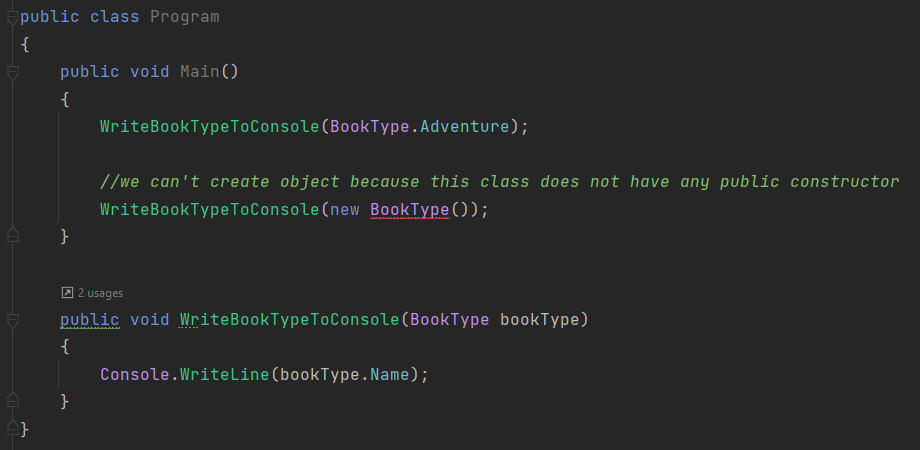In this post, we will take a look at the Enum type in C#. We should use the Enum type carefully and in this article I aim to show how we can make it more robust by using the strongly typed enum pattern.
Let’s started.
According to the C# guide:
The Enum type is a value type defined by a set of named constants of the underlying integral numeric type.
As seen in the description, Enum type is kind of a syntactic sugar that improve the readability of the application code. By default, the associated values of enum member are integer.
But as with everything, also software development is full of trade-offs. It improves readability but also introduces a vulnerability. Because the Enum type is a numeric type as described above and can be manipulated by any numeric value.
Let’s assume, we got an enum named BookType as below:
public enum BookType
{
Undefined = 0,
Adventure = 1,
History = 2,
Dystopia = 3,
Others = 4
}
We can use this enum as a parameter and directly take that value and save it to the database:
public async Task CreateBookAsync(string bookName, BookType bookType)
{
var book = new Book(1, bookName, bookType);
await _bookRepository.InsertAsync(book);
}
There is a problem with this code. We used the BookType enum to ensure book types will be one of the values that we defined in the enum. So, we expect in our database, the BookType column has a value between 0 and 4.
But, we can call the CreateBookAsync method and set the bookType parameter as 10 (or any other numeric value) as below:
//create a book
await _bookAppService.CreateBookAsync(bookName: "1984", bookType: (BookType)10);
When we call the method, there won’t be any build-time error and a record will be added to the database. However, this is not our intention and not what we expect.
How we can improve this and ensure the value will be in the specified range?
We can use the “Strongly Typed Enum” pattern to overcome this problem and make it more robust.
We can use data attributes, such as the Range attribute with Enums where we use it. But, then when we add a new member to the enum then we would also need to change the max value of the range etc..
Strongly Typed Enum Pattern
Instead of using an Enum type, we can create a class and implement type-safe enum pattern:
public class BookType
{
public static BookType Undefined { get; } = new BookType(0, "Undefined");
public static BookType Adventure { get; } = new BookType(1, "Adventure");
public static BookType History { get; } = new BookType(2, "History");
public static BookType Dystopia { get; } = new BookType(3, "Dystopia");
public static BookType Others { get; } = new BookType(4, "Others");
public int Number { get; private set; }
public string Name { get; private set; }
private BookType(int number, string name)
{
Number = number;
Name = name;
}
}
- Here, first we’ve defined a class with private constructor. By doing this we are ensuring an object can not be created with this class.
- In addition to that, we are setting book type values as static, thus these values directly can be used.
- Also, we are setting the setter of these class properties’ as private, so these properties can not be changed out of this class.
After this implementation, if we call our CreateBookAsync method with a different value than what we defined in the BookType class, we will get errors.

Now, we can ensure the value of the book type.
Listing enum values are necessary for most of the applications (we might want to use it in a dropdown for instance) and it is an another challenge. This pattern also simplify that.
We can create a list method in the BookType class and use it for listing enum values whenever needed:
public class BookType
{
//...
public static List<BookType> ListBooks()
{
return typeof(BookType).GetProperties(BindingFlags.Public | BindingFlags.Static)
.Where(bookType => bookType.PropertyType == typeof(BookType))
.Select(x => (Role)x.GetValue(null, null))
.OrderBy(x => x.Name)
.ToList();
}
}
So far, we’ve seen both approaches/usages. Let’s list the some of pros and cons of these usages:
| Enum Type | Strongly Typed Enum Pattern |
|---|---|
| (+) Easy to use, can be used in entity classes and directly mapped with database tables. | (-) Can not be directly mapped with the database tables. (a numeric value can be used instead) |
| (+) Can be used as bit flags. | (-) Can not be used as bit flags. |
| (-) Can be easily manipulated. | (+) Hard to manipulate and more robust design. |
| (-) Harder to list enum values. (Usually needs to use Description attribute for display name) | (+) A List method can be implemented and values listed. |
Conclusion
In this post, I tried to talk about possible problems we might face, while using the Enum type and implemented the Strongly Typed Enum pattern to overcome possible problems.
The Enum type is used very often in our daily codes, but we need to be aware of its edge cases and use it carefully. I wanted to highlight this and consider about it.
Thanks for reading the post, see you in the next one.

